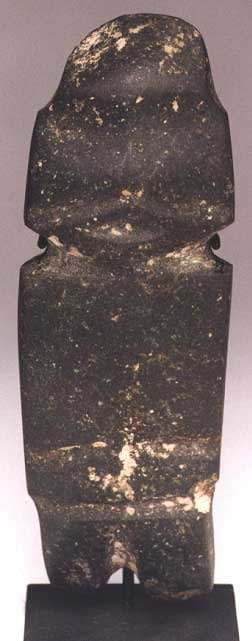Mezcala Stone Standing Figure, 500 BCE - 100 CE
Stone
PF.3191
For the art lover, Guerrero is, above all, the land of Mezcala sculpture. These ancient people who inhabited the Guerrero region, which extends south of Rio Balsas, near Xochipala and...
For the art lover, Guerrero is, above all, the land of Mezcala sculpture. These ancient people who inhabited the Guerrero region, which extends south of Rio Balsas, near Xochipala and Mezcala, seem to have worshipped the axe. The axe was possibly an emblem of strength and authority in the beginning, and later an instrument of the gods of rain and lightening. This sculpture is shaped like an anthropomorphic celt. It represents a standing figure depicted frontally with its arms folded in front. It is so sober and schematic that it tends to become an abstraction. The head is separated from the body by a groove and is large. A depression separates the body from the legs, and the limbs are indicated only by a triangular incision. The intense geometry of the piece is more pronounced due to the sculptor tackling the hard material by defining planes, cutting out and sawing grooves. The face consists of a practically flat plane for the forehead and of two recessed vertical planes that intersect, their edges being the nose and the chin. The mouth is a large lozenge-shaped groove and deep incisions suggest the arms and separate the legs from the body. The genitals are not indicated. This austere, impressive and monumental work evokes the art of the Cyclades or of Easter Island. This sculpture was placed in a tomb. Did it represent the deceased or a deity of rain and lightning? The latter possibility is backed up by the fact that in Mexico City, anthropomorphic Mezcala figures were found among the offerings given to Tlaloc. Perhaps the deceased owner of this Mezcala figure was a devotee of the deity of the rain. The original beauty of this fine work of art remains unsurpassed by its contemporaries and continues to be appreciated from ancient hands to the present.



